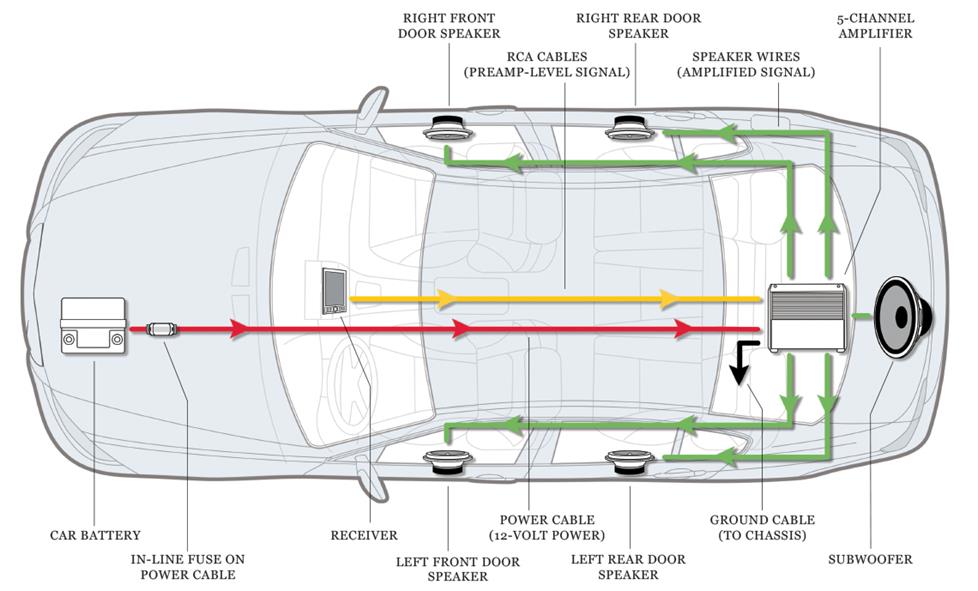Unlocking Deeper Audio Integrating a Powered Subwoofer with Your Amplifier
Want to transform your listening experience? Integrating a powered subwoofer with your amplifier can dramatically enhance your audio setup, providing deeper bass and a more immersive soundscape. This guide provides a comprehensive walkthrough of linking a powered subwoofer to your amplifier, empowering you to unlock the full potential of your audio system.
Many audio enthusiasts are looking to enrich their sound experience. Adding a powered subwoofer to an existing amplifier setup is a popular method for boosting low-frequency output, making music, movies, and games more dynamic. But connecting these components can be daunting for newcomers. Understanding the process is key to avoiding frustration and achieving optimal sound.
The concept of connecting amplifiers and subwoofers has been around since the advent of high-fidelity audio. Early implementations were complex and often required custom wiring. The introduction of powered subwoofers, containing their own built-in amplifiers, simplified the process significantly. Today, connecting a powered subwoofer is relatively straightforward, yet requires careful attention to detail.
One of the most common issues encountered when integrating a powered subwoofer is a lack of output or unexpected humming noises. These problems often stem from incorrect cable connections, improper settings on the amplifier or subwoofer, or grounding issues. Understanding these potential pitfalls can help ensure a seamless setup experience.
Before diving into the connection process, it's essential to understand the different types of connections. Most powered subwoofers offer line-level inputs, often labeled "Line In" or "LFE (Low-Frequency Effects)". Some amplifiers have dedicated subwoofer outputs, usually labeled "Sub Out" or "Subwoofer". This guide will address both scenarios, providing clear instructions for each connection type.
Connecting a powered subwoofer through the "Sub Out" on your amplifier is typically the simplest method. Using a single RCA cable, connect the "Sub Out" on the amplifier to the "Line In" or "LFE" input on the subwoofer. This direct connection ensures the subwoofer receives the appropriate low-frequency signals from your amplifier.
If your amplifier lacks a dedicated "Sub Out," you can connect the subwoofer using the line-level outputs on your amplifier. These outputs are often labeled "Pre-Out." Using an RCA cable, connect the "Pre-Out" on the amplifier to the "Line In" or "LFE" input on the subwoofer.
Benefits of Connecting a Powered Subwoofer:
1. Enhanced Bass Response: A subwoofer drastically improves the low-frequency performance of your audio system, adding depth and impact to music, movies, and games. Example: Explosions in movies become more visceral, and bass lines in music become more pronounced.
2. Improved Overall Sound Quality: By handling the low frequencies, the subwoofer frees up your main speakers to focus on midrange and high frequencies, leading to clearer and more defined sound. Example: Vocals and instruments become more distinct and less muddled.
3. Greater Immersion: The added bass response creates a more immersive listening experience, drawing you deeper into the music, movies, or games you enjoy. Example: You feel more involved in the action of a movie scene.
Step-by-Step Guide:
1. Ensure both your amplifier and subwoofer are turned off.
2. Connect the RCA cable from your amplifier's "Sub Out" or "Pre-Out" to the subwoofer's "Line In" or "LFE" input.
3. Adjust the volume and crossover frequency settings on both your amplifier and subwoofer to achieve your desired sound.
Frequently Asked Questions:
1. What type of cable do I need? Typically, an RCA cable.
2. My subwoofer isn't producing sound, what should I check? Ensure all connections are secure and the volume is turned up on both the subwoofer and the amplifier.
3. What is the crossover frequency? This setting determines the frequency range handled by the subwoofer.
4. Can I connect two subwoofers to my amplifier? It depends on the amplifier; check the manufacturer’s instructions.
5. What does LFE stand for? Low-Frequency Effects.
6. How do I adjust the phase on my subwoofer? Consult the subwoofer's manual for instructions.
7. What is the best placement for a subwoofer? Experiment with placement to find the optimal location in your room.
8. My subwoofer is humming, what should I do? Check for grounding issues or try a different power outlet.
Tips and tricks: Consider using high-quality RCA cables for improved signal transfer. Experiment with subwoofer placement and crossover frequency settings for optimal sound quality. Consult your amplifier and subwoofer manuals for specific instructions and troubleshooting tips.
Integrating a powered subwoofer with your amplifier is a valuable upgrade that significantly elevates your audio experience. By following the steps outlined in this guide, you can unlock deeper bass, improved overall sound quality, and a more immersive soundscape. Whether you're a seasoned audiophile or just beginning your journey into high-fidelity audio, connecting a powered subwoofer is a relatively simple yet rewarding enhancement. Take the time to carefully connect your components, adjust the settings to your preference, and enjoy the transformative power of enhanced bass. By understanding the nuances of connecting your amplifier and subwoofer, you're empowering yourself to create a truly captivating listening environment. Don't hesitate to experiment and find the perfect configuration that suits your individual needs and preferences. The richer, more immersive audio experience is well worth the effort.
Nyc memorial day weekend your ultimate guide
Triceratops family tree uncovering the lineage of a prehistoric giant
Snag a unique instagram handle the ultimate guide to rare usernames














